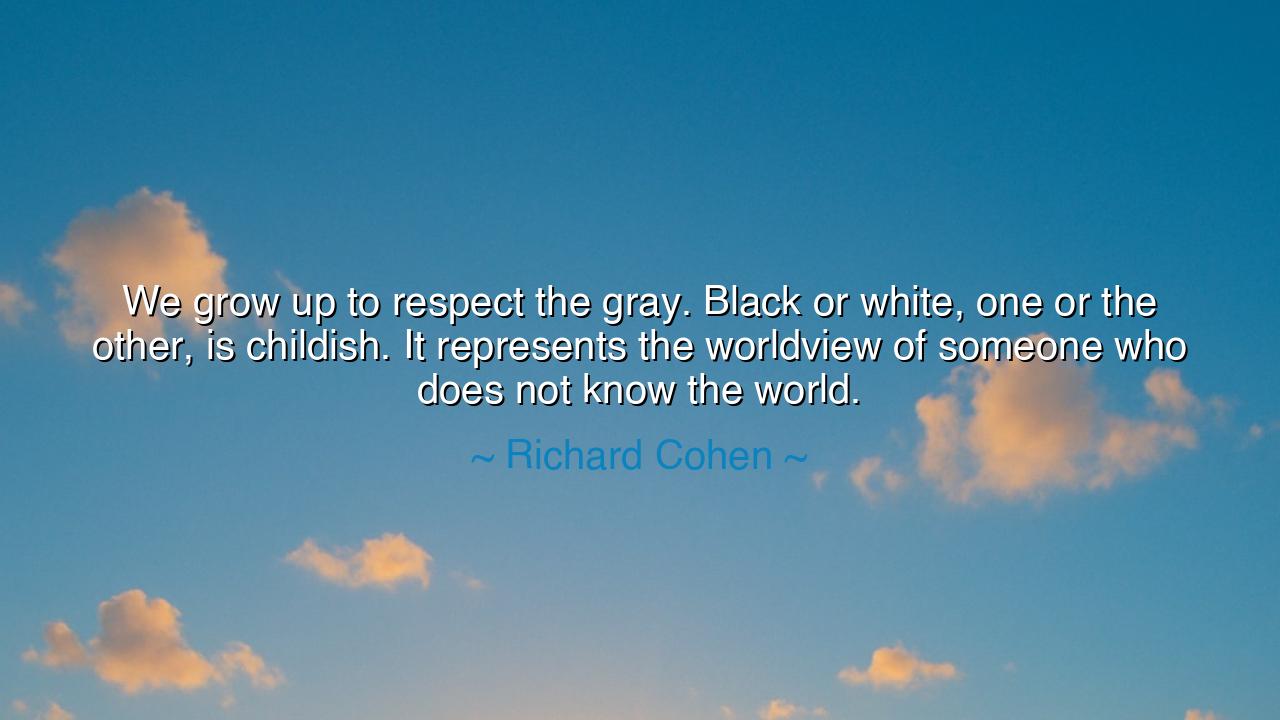
We grow up to respect the gray. Black or white, one or the other
We grow up to respect the gray. Black or white, one or the other, is childish. It represents the worldview of someone who does not know the world.






"We grow up to respect the gray. Black or white, one or the other, is childish. It represents the worldview of someone who does not know the world." This quote from Richard Cohen speaks to the deeply human truth that life, and our understanding of it, is not simply a matter of stark duality—not just black or white, right or wrong—but a rich tapestry of shades of gray, complexity, and nuance. To truly grow and understand the world is to embrace complexity, to recognize that life is rarely clear-cut, and the answers to our deepest questions often lie in the ambiguity between extremes.
The ancient Greek philosophers recognized this truth when they spoke of the balance and harmony inherent in the world. Aristotle, in his work on ethics, taught that virtue lies in the balance between extremes, a golden mean that avoids the excess of both excess and deficiency. To see the world in only black and white—to view things as all good or all bad—was to miss the profound wisdom that lies in understanding both sides of a matter. The wise man, Aristotle argued, recognizes the complexity of life and navigates it with moderation and discernment. To accept the gray is to accept life’s nuances, to see not only opposites but the connections between them.
Similarly, in ancient China, the Taoist philosophy, especially as expressed in the Tao Te Ching, teaches that the world is filled with contradictions that are not only inevitable but essential for harmony. The yin and yang, the dual forces that represent opposites, are not in conflict, but complementary. Laozi explained that to live wisely is to recognize that the true path lies not in choosing one side, but in understanding the interplay of forces, in accepting the gray areas where balance and harmony arise. To see the world in black or white, as the Taoists understood, is to reject the inherent complexity of life and the interdependence of all things.
In the realm of history, we see examples of those who embraced the gray and sought to understand the complexity of life. Nelson Mandela is a powerful figure in this regard. Born in a world of racial segregation and injustice, Mandela could have embraced a black and white worldview—seeing only good and evil in terms of races. Instead, he sought reconciliation, recognizing that the true path to peace required understanding the complexity of human nature, the wounds of both the oppressed and the oppressors. His journey was one of embracing the gray, of forgiving where others sought revenge, and understanding that true justice lies not in absolutes, but in healing and growth.
This concept is also echoed in Mahatma Gandhi, who sought not to divide India into clear black and white divisions of religious and cultural identity, but to find a way to unite through tolerance and respect for differences. Gandhi’s worldview transcended the duality of religious conflict, embracing the gray areas where coexistence could be found. He saw that extremes—whether in the form of violence or in rigid religious boundaries—only perpetuated suffering. By respecting the gray areas, he created a path for peace, one that recognized the complexities of human life and the deep connections between all people.
The lesson from Cohen’s quote is one of profound wisdom: maturity and wisdom come from embracing the complexity of the world. Life is rarely as simple as right versus wrong, good versus evil, or black versus white. The truly wise are those who see the shades of gray, who acknowledge the contradictions and tensions that exist in every situation. It is in the gray where growth occurs, where understanding deepens, and where true progress can be made. To view the world in absolutes is to simplify it, to miss the profound nuances that lie beneath the surface of every conflict, every relationship, and every decision.
In our own lives, we must seek balance and embrace the gray. We must recognize that certainty can often be a sign of closed-mindedness, and that the answers to the deepest challenges we face lie in understanding, compromise, and acceptance of life’s complexities. Whether in personal relationships, work, or society, let us strive to be open to the multiple perspectives that exist, recognizing that wisdom lies not in being right, but in being aware, empathetic, and ready to learn from all sides.
Thus, the challenge of life is not to demand clarity in every situation, but to embrace the gray—to live with humility, openness, and wisdom. It is through this embrace of complexity that we find the true richness of the human experience. Just as the ancient philosophers, leaders, and sages recognized, we too must learn to live with balance, understanding that the gray is not a space of confusion, but of opportunity for deeper connection, learning, and growth.






AAdministratorAdministrator
Welcome, honored guests. Please leave a comment, we will respond soon